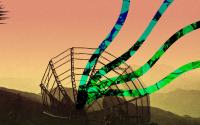By Geoffrey Lean, Environment Editor
Published: 07 May 2006
Global warming is rapidly melting the ice-bound roof of the world, and turning it into desert, leading scientists have revealed.
The Chinese Academy of Sciences - the country's top scientific body - has announced that the glaciers of the Tibetan plateau are vanishing so fast that they will be reduced by 50 per cent every decade. Each year enough water permanently melts from them to fill the entire Yellow River.
They added that the vast environmental changes brought about by the process will increase droughts and sandstorms over the rest of the country, and devastate many of the world's greatest rivers, in what experts warn will be an "ecological catastrophe".
The plateau, says the academy, has a staggering 46,298 glaciers, covering almost 60,000 square miles. At an average height of 13,000 feet above sea level, they make up the largest area of ice outside the polar regions, nearly a sixth of the world's total.
The glaciers have been receding over the past four decades, as the world has gradually warmed up, but the process has now accelerated alarmingly. Average temperatures in Tibet have risen by 2 degrees Fahrenheit over the past 20 years, causing the glaciers to shrink by 7 per cent a year, which means that they will halve every 10 years.
Prof Dong Guangrong, speaking for the academy - after a study analysing data from 680 weather stations scattered across the country - said that the rising temperatures would thaw out the tundra of the plateau, turning it into desert.
He added: "The melting glaciers will ultimately trigger more droughts, expand desertification and increase sand storms." The water running off the plateau is increasing soil erosion and so allowing the deserts to spread.
Sandstorms, blowing in from the degraded land, are already plaguing the country. So far this year, 13 of them have hit northern China, including Beijing. Three weeks ago one storm swept across an eighth of the vast country and even reached Korea and Japan. On the way, it dumped a mind-boggling 336,000 tons of dust on the capital, causing dangerous air pollution.
The rising temperatures are also endangering the newly built world's highest railway, which is due to go into operation this summer. They threaten to melt the permafrost under the tracks of the £1.7bn Tibetan railway, constructed to link the area with China's northwestern Qinghai province.
Perhaps worst of all, the melting threatens to disrupt water supplies over much of Asia. Many of the continent's greatest rivers - including the Yangtze, the Indus, the Ganges, the Brahmaputra, the Mekong and the Yellow River - rise on the plateau.
In China alone, 300 million people depend on water from the glaciers for their survival. Yet the plateau is drying up, threatening to escalate an already dire situation across the country. Already 400 cities are short of water; in 100 of them - including Beijing - the shortages are becoming critical.
Even hopes that the melting glaciers might provide a temporary respite, by increasing the amount of water flowing off the plateau - have been dashed. For most of the water is evaporating before it reaches the people that need it - again because of the rising temperatures brought by global warning.
Yao Tandong, head of the academy's Qinghai-Tibet Plateau Research Institute, summed it up. "The full-scale glacier shrinkage in the plateau regions will eventually lead to an ecological catastrophe," he said.
Global warming is rapidly melting the ice-bound roof of the world, and turning it into desert, leading scientists have revealed.
The Chinese Academy of Sciences - the country's top scientific body - has announced that the glaciers of the Tibetan plateau are vanishing so fast that they will be reduced by 50 per cent every decade. Each year enough water permanently melts from them to fill the entire Yellow River.
They added that the vast environmental changes brought about by the process will increase droughts and sandstorms over the rest of the country, and devastate many of the world's greatest rivers, in what experts warn will be an "ecological catastrophe".
The plateau, says the academy, has a staggering 46,298 glaciers, covering almost 60,000 square miles. At an average height of 13,000 feet above sea level, they make up the largest area of ice outside the polar regions, nearly a sixth of the world's total.
The glaciers have been receding over the past four decades, as the world has gradually warmed up, but the process has now accelerated alarmingly. Average temperatures in Tibet have risen by 2 degrees Fahrenheit over the past 20 years, causing the glaciers to shrink by 7 per cent a year, which means that they will halve every 10 years.
Prof Dong Guangrong, speaking for the academy - after a study analysing data from 680 weather stations scattered across the country - said that the rising temperatures would thaw out the tundra of the plateau, turning it into desert.
He added: "The melting glaciers will ultimately trigger more droughts, expand desertification and increase sand storms." The water running off the plateau is increasing soil erosion and so allowing the deserts to spread.






